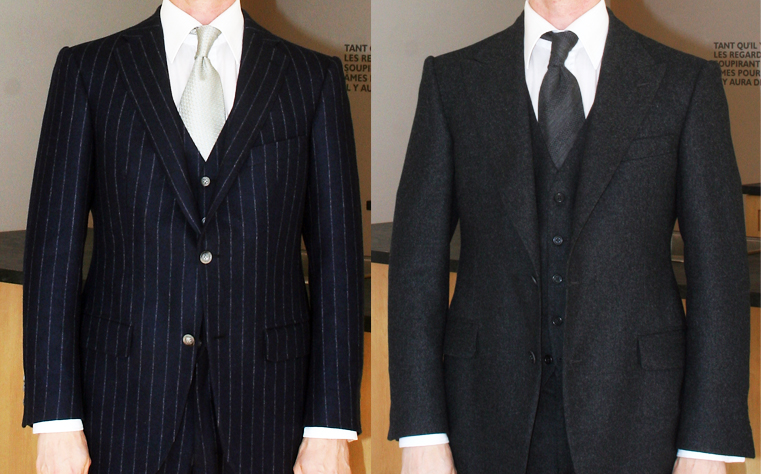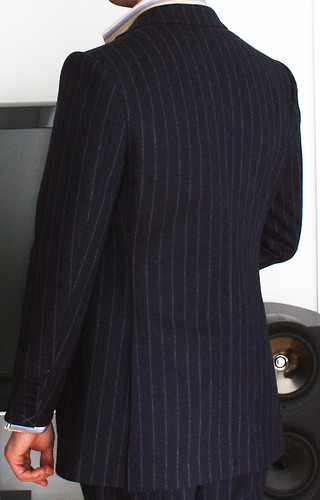OK so here are the finished garments. The navy is Harrisons and the charcoal is J&J Minnis. Aside from the differences in lapel, the Minnis was drafted using Whife, with no side body (which I think contributes to that wobbliness on the front) and the Harrisons was drafted using the Mitchell system. Each system has its strengths and weaknesses, but I definitely vote for separate side body- it's far easier to get a good fit with it. I used my own sleeve system adapted to each draft, which worked out better on the Mitchell system than on Whife.
Thoughts?
Thank you, all, for your comments.
Karen, here is a partial backview of the Harrisons, taken before it was finished. I'll get better shots of both of them soon.
And you are quite right, a donlon wedge at the level of the pocket would have fixed the front or the Minnis, but a separate side body is required for that, which was why I expressed that preference. That's the thing about experiments; sometimes they don't turn out the way you would have wanted them to. That's why I make so many suits for myself- I wouldn't want to experiment on a client's suit and the best way to learn is to try new things out and make mistakes. So it's all good
Superfluidity? You have taught me a new term, Jordan. But what do you mean by it? They are both pickstitched by hand, ever so discretely, to keep the edge crisp and flat. Perhaps you would have liked a swelled edge or a more decorative stitch?
Regarding the drafts, Whife was the editor of the Modern Tailor, Outfitter and Clothier, a massive 3-volume encyclopedia of tailoring last published, I think, in 1951. It's now something of a collector's item.
The Mitchell System was published by Frank C. Doblin in the 1950s as the New Mitchell System, and then in the 70s as the Modern Mitchell system- I believe that they are still available, and a few pages of the New Mitchell System are available oon the Cutter and Tailor forum. I originally learned a system very close to this, and later studied this system, but abandoned them for what I thought were systems which made more sense to me, since the drafts need to be "straightened" after cutting them out- that is to say, the main construction lines are not parallel to the grain lines, which is a pain when grading or trying to cut directly to cloth. I was speaking recently with a tailor who uses and speaks highly of the system so I decided to give it another go. He likes the sleeve draft, so long as you don't change the scye- I am particular about the scye fit and so used my own sleeve system for this draft. It should also be noted that neither of these garments fit like this "out of the box" (from the first draft) several fittings were necessary, as usualy, to get them to a point where I was somewhat satisfied with the fit so anyone using these systems should not feel discouraged if their first attempt at a draft does not fit as well as they expect. It should also reinforce the notion that fitting skills are more important than drafting systems- there is no magical system which is always perfect, and so long as your fitting skills are strong, you will get decent results no matter the system used.
A last note about these systems- they were published as guides for trained cutters and not as a step-by-step manual to teach how to cut patterns; it was assumed that one already had a firm understanding of drafting or was under the guidance of someone who did. If you are just starting out it is very easy to make all sorts of mistakes, and very hard to spot those mistakes; I would advise anyone who is just learning drafting to find someone who is familiar with the systems to give them some guidance for their first few drafts or to be prepared for a bit of frustration at first.








19 comments:
Not my aesthetic but they both look very very good.
Like them both; the sleeve is very attractive on both. Can we have a back view? As a dressmaker, I might have tried a dart on the lower front, under/in the pocket, to take away that bit of bubble.
Ahh, finally. Lovely work, Jeffery, on both suits. Had the navy from Harrisons of Edinburgh been made for me, I might have asked that the vest include rolled notch lapels. Further, I might have asked for a superfluidity of pick-stitching by hand on the suit overall. But these are your latest projects and your sensibility and they truly deserve a hearty Bravo!
JMB
By superfluidity, I mean tasteful and understated detailing on a suit. At first glance, you may not notice the pickstitching, but on closer inspection you realize how artful and meticulous the handwork really is. It's on the edge of the collar and continues along the lapels and keeps going nonstop below the button stance. More of the same subtle detailing on the breast pocket and the lower flap pockets, too, if you have a mind to turn them out to reveal the stitched edges, though I prefer the clean closed line of jetted pockets on striped flannel and worsted pick and pick suits. Still more meticulous handstitching on the underside of the sleeve button vents. Tom Wolfe called working sleeve buttons a guilty pleasure. It isn't so much that they actually unbutton; it's the labor and detailing of how beautifully they're stitched. All of that adds up to attention to detail.
A swelled edge or more flamboyant decorative stitching is overkill. It's too much. I agree with you that pickstitching by hand should be ever so discreet. If a suit is well made and the details are thought out and kept in control, it makes all the difference. Flashly linings and other inappropriate details cheapen a suit. If you need to add a little punch to a suit, you can always do with your choice of accessories.
JMB
Oops! I neglected to mention the detailing on the other parts of a beautifully tailored suit. If a vest with rolled notch lapels is part of the rig there should be more pickstitching by hand, not only to keep the edges flat and crisp but also to detail the four pockets. Similarly, the trousers need to be detailed, though the stitching on them is different from the jacket and vest.
JMB
Those are beautiful sleeves, front and back.
On further reflection about what I meant by superfluidity, it's the continuity of detailing that a tailor applies to a suit or any other kind of bespoke clothing. The particular 'signature' of the detailing depends upon the cloth and the vision of the tailor. In architecture, detailing is often referred to as pattern language, which implies a continuity to the style of a particular structure. In tailoring, detailing is key to artistry.
JMB
Both costumes are magnificent.
It may prompt where you can take the book with
Mitchell system.
Love the shape and roll of the lapels on the grey one. Do the lapels on the navy one roll like that too when unbuttoned?
Thanks, MC
A peak lapel, being wider than a notch, allows a much wider belly shape to it so with proper handling I can get a much richer roll to it- I love doing peaks for that reason but they're a little dramatic at that width for everyday wear. The navy does roll higher when unbuttoned, but it's not quite as rich as the grey.
I never post comments on sites, but I feel the need to express my thanks to you. I am a complete novice at men's fashion and I, like most men, was unaware at the level of detail that goes into a jacket. I ran across your site and I'm soaking in all these details that would otherwise go unnoticed when selecting a suit. I'm in law enforcement and I can assure you that the majority of my coworkers are unaware of the detail that you explain so eloquently. I will spread the word about your site. Thanks for the knowledge and for saving me embarrassment.
Sgt. RF
Absolutely beautiful work! Well done.
Do you mind if I ask which of the Minnis flannels you have used for the grey suit? Is it pattern 0301 or 0317, the heavier flannel?
Also, what is your opinion of the the heavy flannels (16.5 - 17oz) in general?
Finally, thank you for your blog. It really is quite terrific.
@philstan- it was the 0317. 17 oz flannels are good for overcoats. While they make up fairly nicely, I just think that they are too heavy for wear as suiting in climate-controlled environments. I, personally, like the 11 oz range the best.
These are two of the nicest suits i have seen around, they both look flawless to me " from the pictures" one thing i would change though would be the 4 in hand knot of the tie! why not do a full windsor knot? its fuller, gives better shape and stands better and with the little dimple in the bottom of the knot i feel would compliment the magnificent suits
"I appreciate the tips! For premium cat food options, aonepets.pk offers Reflex Plus and Pawfect, which have worked wonders for my feline."
Wanpy cat treat
"This blog post has definitely inspired me to explore this topic further. I’m always on the lookout for insightful content like this."
Weight-Loss Service
This is such valuable information, and it came at the right time for me. Thank you!
Nourvet cat food
Great content! I appreciate how you explained everything so clearly.
best psychiatrist doctor in islamabad
This post was very timely for me. Thanks for sharing your expertise.
mental health practitioner
Post a Comment